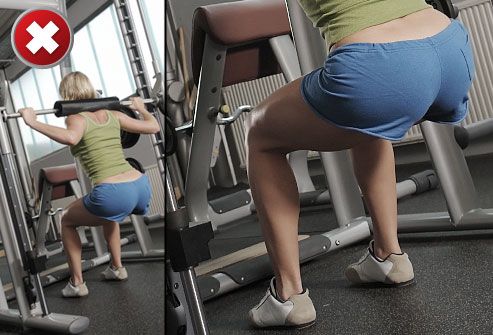1. "REWARDING YOURSELF"
 |
| "I just ran, that means it's okay for me to eat this cake" |
All of the time I hear people, females in particular, talk about how they just went running or did some cardio so it makes it okay to "reward" themselves with a big piece of cake or ice cream. This is so incorrect it is not even funny. First of all, what is the point of even going out and running if you are just going to throw it all away by eating junk. You might as well not even go out and run. Second, these people think they still got fat loss benefit out of the running when in fact, they take in more calories during the reward than they burn while doing cardio. If an average person runs for 30 minutes at a pace of 10 minutes per mile, they will burn about 300 calories. In one cup of ice cream, there are appoximately 290 calories. And that is if the person only eats one cup of ice cream, which we all know, is not very much ice cream.
2. THE SMITH MACHINE
 |
| Look how far forward her legs are, is that a position a person could be in naturally? |
Now, I would just like to say that I do think the smith machine has its uses, such as for shrugs and calf raises, but what I see waaaay too often is people using the smith machines for benching and squatting and thinking this will make them stronger. I understand why people use them, because they are considered "safer" because you don't need a spotter, and because you can put more weight on it to try to look like you are strong. But, just because you won't drop the weight on yourself does not mean that it is safer. The reasons the smith machine is less safe than barbell and free weights is because it restricts your plane of motion. Your body is not naturally built to go in straight lines up and down with any wiggle room from side to side. Another reason these machines are not good for strength training is because they take your stabilizer muscles out of the workout and just isolate muscles, meaning the only thing you are actually getting stronger at is the smith machine workout, not actually functional strength.
3. DOING ABS ONLY
First of all, I would like to say ab workouts have their place in a workout as it is completely necessary to build core strength. But I see too many overweight people doing crunches and thinking that that is what is going to get them to have a six-pack. A six-pack does not come from having super strong abs, it comes from having a low bodyfat percentage. So, instead of doing 500 crunches, fix your diet and get on the treadmill.
4.NOT LIFTING HEAVY
This one is mainly for the females. "I don't want to get big and bulky." You hear this from females all the time at the gym. I do not know where this misconception came from that lifting heavy weights makes you turn into a man and get huge. It has been proven that a woman should work out no differently than a man. Girls, you are not going to get huge muscles by lifting weights, it is not in a females genetics for that to happen without many years of lifting for the purpose to become a female bodybuilder.
5. NOT EATING WHILE ON A "DIET"
This is one of the main diet misconceptions in the world. "If I want to lose fat, I just won't eat." This actually ends up having the opposite effect on a person. If you don't eat, then your metabolism doesn't have to work which in turn makes your metabolism weak. If you want to lose weight, eat less food more often. 5-8 meals per day keeps your metabolism working. Throw in cardio and a workout program and you are good to go for fat loss.


![[LayneNorton02.jpg]](https://blogger.googleusercontent.com/img/b/R29vZ2xl/AVvXsEggU8bLcjc4HGGCvYbhP1hbJ-KyyZf4FmBfEx6qFC3FHbOTqlVFbrED5K-eIIWrQAd7rZbo-cJnrCVblpVSFyBvOpMOU13xUWC_nOm4h3_W6mBfMKgbjqEvHUWjvS4OgxBlzalCiY7Hc2c/s1600/LayneNorton02.jpg)